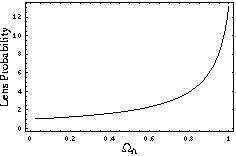


3.4 Gravitational lensing
The volume of space back to a specified redshift, given by
(44), depends sensitively on 
 . Consequently,
counting the apparent density of observed objects, whose actual
density per cubic Mpc is assumed to be known, provides a potential
test for the cosmological constant
[112,
113,
114,
3]
Like tests of distance vs. redshift, a significant problem for
such methods is the luminosity evolution of whatever objects
one might attempt to count. A modern attempt to circumvent
this difficulty is to use the statistics of gravitational lensing
of distant galaxies; the hope is that the number of condensed
objects which can act as lenses is
less sensitive to evolution than the number of visible objects.
. Consequently,
counting the apparent density of observed objects, whose actual
density per cubic Mpc is assumed to be known, provides a potential
test for the cosmological constant
[112,
113,
114,
3]
Like tests of distance vs. redshift, a significant problem for
such methods is the luminosity evolution of whatever objects
one might attempt to count. A modern attempt to circumvent
this difficulty is to use the statistics of gravitational lensing
of distant galaxies; the hope is that the number of condensed
objects which can act as lenses is
less sensitive to evolution than the number of visible objects.
In a spatially flat universe,
the probability of a source at redshift zs being
lensed, relative
to the fiducial ( M = 1,
M = 1,

 = 0) case, is given by
= 0) case, is given by
where as = 1 / (1 + zs).
Figure 9. Gravitational lens probabilities
in a flat universe
with
As shown in Figure (9), the probability rises
dramatically
as
Analysis of lensing statistics is complicated by
uncertainties in evolution, extinction, and biases in the lens
discovery procedure. It has been argued
[115,
116]
that the existing data allow us to place an upper limit of


 M +
M +

 = 1, relative to
= 1, relative to
 M = 1,
M = 1,

 = 0, for a source
at z = 2.
= 0, for a source
at z = 2.

 is increased to unity as we
keep
is increased to unity as we
keep  fixed.
Thus, the absence of a large number of such lenses would imply an
upper limit on
fixed.
Thus, the absence of a large number of such lenses would imply an
upper limit on 
 .
.

 < 0.7 in a flat
universe. However, other groups
[117,
118]
have claimed that the current data actually favor a nonzero cosmological
constant. The near future will bring larger, more objective
surveys, which should allow these ambiguities to be resolved.
Other manifestations of lensing can also be used to constrain
< 0.7 in a flat
universe. However, other groups
[117,
118]
have claimed that the current data actually favor a nonzero cosmological
constant. The near future will bring larger, more objective
surveys, which should allow these ambiguities to be resolved.
Other manifestations of lensing can also be used to constrain

 , including statistics of
giant arcs [119],
deep weak-lensing surveys
[120], and
lensing in the Hubble
Deep Field [121].
, including statistics of
giant arcs [119],
deep weak-lensing surveys
[120], and
lensing in the Hubble
Deep Field [121].